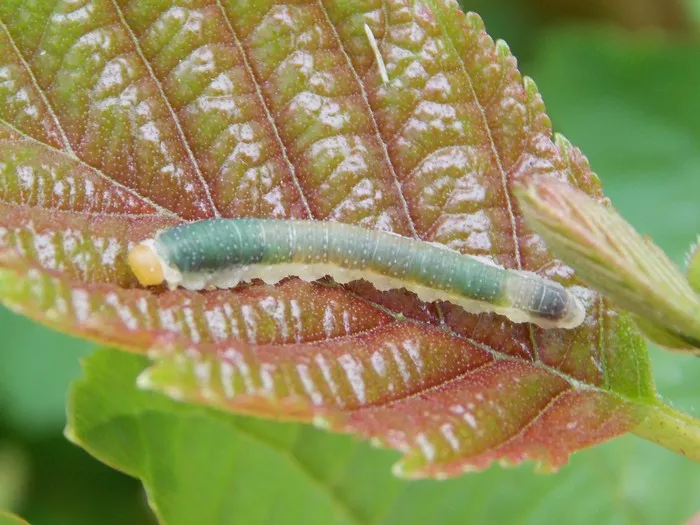Rose enthusiasts invest time and effort into cultivating these beautiful flowering plants, only to find them marred by the presence of rose slugs. These tiny, voracious pests can quickly strip the foliage of roses, leading to unsightly damage and potential decline in plant health. However, with a combination of identification, prevention, and control measures, gardeners can effectively manage rose slug infestations without resorting to harsh chemicals. In this comprehensive guide, we explore the lifecycle of rose slugs, the damage they cause, and a range of organic, natural, and chemical control methods, along with preventative measures to safeguard rose gardens.
Identifying Rose Slugs
Rose slugs, also known as sawfly larvae, are the immature stage of sawflies belonging to the Hymenoptera order. These pests typically measure about 1/2 inch long and have a slimy, greenish-yellow appearance. They often feed on the undersides of rose leaves, leaving behind a telltale trail of skeletonized foliage. As they mature, rose slugs may darken in color or develop darker spots along their bodies.
Their lifecycle begins when adult sawflies lay eggs on the undersides of rose leaves in spring. These eggs hatch into larvae, which feed voraciously on the leaf tissue for several weeks before pupating in the soil. The emerging adult sawflies then restart the cycle by laying more eggs, perpetuating the infestation.
It’s crucial to distinguish rose slugs from other common rose pests, such as aphids and caterpillars. While aphids tend to cluster on new growth and excrete honeydew, caterpillars have distinct body segments and often consume entire leaves. Rose slugs, on the other hand, leave behind a characteristic pattern of skeletonized foliage, making them relatively easy to identify.
Damage Caused by Rose Slugs
Rose slugs primarily feed on the chlorophyll-rich tissue of rose leaves, leaving behind a lace-like pattern of damage known as skeletonization. This feeding behavior not only compromises the aesthetic appeal of the plant but also reduces its ability to photosynthesize effectively, ultimately weakening its overall health and vigor.
Severe infestations can lead to defoliation, stunted growth, and increased susceptibility to other stressors and diseases. Additionally, the presence of rose slugs can diminish the ornamental value of roses, which are prized for their lush foliage as well as their blooms.
Organic/Natural Control Methods
1. Handpicking: For minor infestations, manually removing rose slugs from plants can be an effective control method. Simply inspect the undersides of leaves and pick off any larvae you encounter. This method is labor-intensive but environmentally friendly and does not rely on chemical pesticides.
2. Water Sprays: Use a strong blast of water from a garden hose to dislodge and remove rose slugs from leaves. This method can be particularly useful for smaller plants or areas where handpicking is impractical. Be sure to target the undersides of leaves where the larvae tend to congregate.
3. Neem Oil: Neem oil, derived from the seeds of the neem tree, acts as a natural insecticide and disrupts the life cycle of rose slugs. Dilute neem oil according to the manufacturer’s instructions and spray it onto affected plants, paying special attention to the undersides of leaves. Repeat applications may be necessary for effective control.
4. Diatomaceous Earth: Diatomaceous earth is a fine powder made from fossilized algae that works by dehydrating and killing soft-bodied pests like rose slugs. Dust the powder onto foliage and soil around rose plants, focusing on areas where larvae are active. Reapply after rain or irrigation to maintain effectiveness.
Chemical Control Methods
While organic and natural control methods are preferred for managing rose slugs, chemical options are available for severe infestations or when other methods have proven ineffective.
1. Insecticidal Soaps: Insecticidal soaps are low-toxicity pesticides that disrupt the cell membranes of soft-bodied insects like rose slugs. Dilute the soap according to the label instructions and spray it onto affected foliage, ensuring thorough coverage. Repeat applications may be necessary to achieve desired results.
2. Chemical Insecticides: When selecting chemical insecticides, choose products specifically labeled for controlling sawflies or rose slugs. Follow all safety precautions and application guidelines provided by the manufacturer. Avoid using broad-spectrum pesticides that may harm beneficial insects and pollinators.
Preventative Measures
In addition to control methods, implementing preventative measures can help reduce the risk of rose slug infestations and promote overall plant health.
1. Garden Cleanup: Remove debris, fallen leaves, and other organic matter from around rose plants, as these provide hiding places for rose slugs and other pests. Regularly prune dead or damaged foliage to improve airflow and reduce potential breeding sites.
2. Encourage Natural Predators: Birds, predatory insects, and parasitic wasps are natural enemies of rose slugs and can help keep populations in check. Avoid using broad-spectrum pesticides that may harm these beneficial organisms, and consider planting companion plants that attract beneficial insects to the garden.
3. Cultural Practices: Maintain healthy rose plants by providing adequate water, sunlight, and nutrients. Proper watering and fertilization promote vigorous growth and resilience against pest infestations. Avoid overfertilizing with nitrogen-rich fertilizers, as this can stimulate excessive foliage growth, making roses more attractive to pests.
Conclusion
By combining proactive management strategies with targeted control methods, gardeners can effectively combat rose slugs and preserve the beauty and vitality of their rose gardens. Whether opting for organic, natural, or chemical solutions, it’s essential to prioritize environmental stewardship and minimize harm to beneficial organisms while safeguarding cherished plants from pest damage.


